Federal Maritime Board
-
- Regulatory Profile: William P. Doyle, Commissioner of the Federal Maritime Commission Maritime Logistics Professional, Q1 2014 #58
If the Federal Maritime Commission remains somewhat of an enigma to domestic maritime stakeholders, perhaps that’s because its scope of oversight reaches many sectors of maritime business; some more obscure than others. In February, we caught up with FMC commissioner William P. Doyle, who provided the perfect primer on this important agency. What does it take to become a Federal Maritime Commissioner? As it turns out; plenty:
Doyle was sworn in on January 10, 2013 as Commissioner of the Federal Maritime Commission. All told, Doyle has over 20 years of experience in the transportation industry, including both the maritime and energy sectors and has held several senior executive positions. These include an executive role as the Director of Permits, Scheduling, and Compliance with the Office of the Federal Coordinator for Alaska Natural Gas Transportation Projects. There, he managed and directed the permitting and regulatory coordination of 24 federal agencies, numerous State of Alaska agencies, and both federal and provincial agencies of Canada. A 1992 graduate of the Massachusetts Maritime Academy, Doyle’s career path has taken him to sea as a marine engineer, into the shipyard and eventually, to law school. Doyle served over a decade as a merchant officer aboard numerous classes of vessels and he also spent as MEBA Deputy General Counsel, Director of Government & Legislative Affairs and later became Chief-of-Staff.
FMC Defined
According to Doyle, The FMC may not be widely known and/or understood, but it has a longstanding, important, and multifaceted role. He explains, “The Mission of the FMC is to foster a fair, efficient and reliable international ocean transportation system and to protect the public from unfair and deceptive practices. We strive to meet that goal in several ways,” adding, “I really do enjoy being a Commissioner.”
The FMC receives complaints and offers alternative dispute resolution services (ombuds assistance, mediation and arbitration) in attempt to reach a timely settlement and has administrative law judges (ALJs) who issue binding decisions. Doyle says, “We act as an appeals court per se, and rule on decisions made by the ALJs and consider appeals of ALJ decisions. Cases we decide include the shipment of goods by small business and disputes between and among marine terminal operators (MTOs) and common carriers.”
High Energy
Of interest to energy stakeholders, Doyle, in a previous life, has served as Representative on the U.S. delegation for the United States on the bilateral trade delegation for the U.S. – Canada Energy Consultative Mechanism meetings, bilateral energy trade issue talks intended to strengthen the largest bilateral energy relationship in the world. Beyond that, he represented the U.S. in the annual coordination meeting between the U.S. Pipeline and Hazardous Materials Safety Administration and Canada’s National Energy Board. And, he was selected by the U.S. Department of State to participate in an international shale gas workshop to assess international resources, supply options, and market conditions.
Cruise Bonding & Consumer Protection
The Commission’s Bureau of Certification and Licensing (BCL) is responsible for Passenger Vessel Certification. The BCL includes the Office of Passenger Vessels and Information Processing (OPVIP). OPVIP receives and reviews applications from passenger vessel operators (PVOs) for Certificates (Performance) and Certificates (Casualty) and the associated coverage evidencing acceptable forms of financial responsibility. In this case, the Certificate (Performance) indicates that the PVO has filed acceptable evidence of financial responsibility with the Commission. The coverage is used to reimburse passengers when the PVO fails to perform cruises as contracted and has taken no further actions to refund passengers. The Certificate (Casualty) indicates that the PVO has filed acceptable evidence of financial responsibility with the Commission which can be used to pay claims for death or injury to passengers and other persons on voyages covered by the program.
Cruise lines typically require that prospective passengers provide a deposit in advance of a voyage. In the cruise industry the collection of deposits from consumers is known as unearned passenger revenue. Doyle says, “That’s fine, but occasionally something goes awry: a scheduled cruise fails to sail or is not completed, or there is a casualty. Since the year 2000, 15 passenger vessel operators have gone out of business, one of which had collected $51 million in deposits from would-be passengers. So, to protect consumers, the FMC requires cruise lines to have proper financial backing to refund passenger deposits should a cruise line fail to perform on its contract.”
Roots: Marad & FMC
FMC’s history dates all the way back to its relationship with the U.S. Maritime Administration and subsequent separation. During World War I, Congress feared that collective liner pricing organizations (conferences) would use their market power to unreasonably raise rates or reduce services. Hence, the Federal Shipping Act of 1916 was enacted, thereby creating the United States Shipping Board. In those days, says Doyle, the United States Shipping Board and its immediate successor organization, the United States Maritime Commission, combined the roles of regulatory policeman and promoter.
Later, the Merchant Marine Act charged the United States Shipping Board with monitoring and responding to foreign regulations that create conditions unfavorable to shipping in the foreign trade. In 1933, an executive order transferred the United States Shipping Board’s functions to the U.S. Shipping Board Bureau in the Department of Commerce. In 1936, Congress separated the Board from the Commerce Department, creating the United States Maritime Commission. Joseph P. Kennedy served as its first Chairman.
In 1950, the regulatory programs of the United States Maritime Commission were transferred to the Federal Maritime Board at the Department of Commerce, where they resided until the FMC’s creation in 1961. And, in 1961, the performance of regulatory and promotional functions were separated, resulting in the formation of the U.S. Maritime Administration and the Federal Maritime Commission.
Doyle explains, “Not just the name changed, the laws we administer are periodically modernized to adjust to the dynamic maritime industry. The Shipping Act of 1984 was enacted, which among other things introduced the concept of contract carriage with service contracts filed with the FMC. In 1998, after a study of the 1984 Act and review by an advisory commission, a second round of deregulatory liner legislation was enacted – The Ocean Shipping Reform Act of 1998.”
Today, FMC works with the U.S. Department of Transportation and MARAD on the recently implemented Value Added Tax (VAT) by the People’s Republic of China (China). The issue pertaining to the VAT is whether there is any unfairness in application of the tax. For the past several years, the United States and China have held annual U.S. Bilateral Maritime Consultations.
FMC also works with MARAD on the Maritime Security Program (MSP). Doyle explains, “I’m mindful that one purpose of the Shipping Act is to encourage development of an economically sound and efficient liner fleet of vessels that is capable of meeting national security needs. I have made it clear that I am a strong supporter of the U.S.-flag. And, in my role as a Commissioner, I make it my business to look after the U.S.-flag international fleet. There’s a lot going on in the international flag fleet—proposed carrier alliances, proposed carrier expansions to vessel sharing agreements and the like—and as we know, major carriers in the MSP are parented by international owners. Some of the carriers who have proposals before the Commission have ships enrolled in the MSP.”
As over-capacity in the international container trades persists, with fuel costs for ships remaining stubbornly high, spot container freight rates have remained low for a long period of time. Noting this, Doyle told MarPro, “Carriers are doing everything they can to cut costs and streamline operations that may include new and/or expanded alliances. That said; I don’t want to see our U.S.-flag international fleet harmed during this period of transformation. The United States relies on these companies and their ships during times of conflict. That’s why it has been so important for me to keep current on latest developments coming out of MARAD.”
The Harbor Maintenance Tax and Trust Fund
In 2012, the FMC undertook a study of U.S. inland containerized cargo moving through ports in Canada and Mexico. At the time, some lawmakers were concerned about whether the Harbor Maintenance Tax (HMT) played a role in cargo being shifted from U.S. ports to ports in Canada and Mexico. While FMC does not have regulatory authority over the HMT, the Commission analyzed potential impacts HMT may have with respect to cargo diversion. FMC ultimately determined that the current HMT structure is just one of several issues shippers weigh in their cargo routing decisions. Doyle adds, “The FMC has communicated its findings to Congress. We will be guided by any legislation enacted by Congress and we continue to offer our comments and expertise when requested.”
FMC and OTI’s
The FMC regulates ocean transportation intermediaries (also known as OTIs). The term OTI encompasses Ocean Freight Forwarders (OFFs) and Non-vessel Operating Common Carriers (NVOCCs). For many, these “brokers” or middlemen are the only parties with which they will interact in moving goods. Doyle insists that businesses should only use FMC- licensed ocean transportation intermediaries for their movements. He adds, “Concurrent with licensed participants, there are unlicensed, rogue operators out there. These are the bad actors, if you will.” To help the shipping public, Doyle explains, the FMC posts a list of licensed OTIs on its website where one can search by a company’s name or by a location. There are approximately 4,000 licensed OTIs in the United States. U.S.-based companies or sole proprietors operating as either an OFFs or NVOCCs are required to obtain a license from the FMC. Non-U.S. based NVOCCs are not required to, but they may obtain an FMC-issued license. Doyle adds, “The general difference between OFFs and NVOCCs is that an NVOCC acts as the carrier of the cargo being sent.” The Commission is currently reviewing comments as a result of an advanced notice of proposed rulemaking that could affect OTIs, with the ultimate goal of balancing the needs of consumers with those of the industry.
The Commission’s Area Representatives also participate in investigations of potential violations of the Shipping Act and Commission regulations, working with Bureau of Enforcement (BOE), which is the prosecutorial arm of the Commission. BOE attorneys also negotiate settlements and informal compromises of civil penalties, and may act as investigative offices in formal fact-finding investigations. During the first 10 months of 2013, the FMC completed seven compromise agreements from companies that violated the Shipping Act. The recovery totaled of $617,500 in civil penalties. The alleged violations include providing service that was not in accordance with the rates or charges contained in their tariffs, failure to be properly bonded and falsifying cargo declarations related to service contracts.
FMC: Fairness, Transparency & Justice for All
Vessel sharing agreements and proposed carrier alliances are another area of FMC oversight. Under the Shipping Act, carriers are allowed limited antitrust immunity. The FMC is currently considering what the trade-press has dubbed “mega alliances” involving the world’s top International container lines interested in expanding or forming vessel sharing arrangements. In reviewing agreements filed with the FMC, the Commission’s regulatory role is to determine whether the agreement is likely, by a reduction in competition, to produce an unreasonable decrease in transportation service or an unreasonable increase in transportation cost.
In December of 2013, the Commission reached compromise agreements with two international-flag car carriers with penalties totaling $2.3 Million. The carriers were found to have acted in concert with other ocean common carriers with respect to the shipment of automobiles and other motorized vehicles by car carrier vessels, where such agreement(s) had not been filed with the Commission or become effective under the Shipping Act. Commission staff alleged that these practices persisted over a period of several years and involved numerous U.S. international trade lanes.
William Doyle says, “It is important that common carriers follow the law. The FMC takes seriously carriers’ obligation to file with the Commission any agreement with other carriers affecting working relationships in the U.S. trades, both for import and export traffic. The shipping public has a right to know the subject matter and scope of any such agreement, and the Commission is charged by Congress to oversee the parties’ operations and conduct under such agreements.”
(As published in the 1Q 2014 edition of Maritime Professional - www.maritimeprofessional.com)
-
- The Logistics of Regulating the Supply Chain Maritime Logistics Professional, Q3 2016 #34
comes to maritime regulations. For example, and in 1950, the regulatory programs of the United States Maritime Commission were transferred to the Federal Maritime Board at the Department of Commerce, where they resided until the FMC’s creation in 1961. Doyle sums up the beginnings of FMC neatly. “Post-World
-
 )
March 2024 - Marine Technology Reporter page: 43
)
March 2024 - Marine Technology Reporter page: 43Image courtesy Kongsberg Discovery Image courtesy Teledyne Marine New Products Teledyne Marine had its traditional mega-booth at Oi, busy start to ? nish. Image courtesy Greg Trauthwein offers quality sub-bottom pro? ling capability without the need tion of offshore windfarms. GeoPulse 2 introduces new
-
 )
March 2024 - Marine Technology Reporter page: 25
)
March 2024 - Marine Technology Reporter page: 25Auerbach explained that ideally, “one ? ed layers of geothermal activity,” noted changes over an area of 8,000 km2. They would have both instruments: seismom- Skett, “and the change in salinity and dis- found up to seven km3 of displaced ma- eters to detect and locate subsurface ac- solved particles for
-
 )
March 2024 - Marine Technology Reporter page: 18
)
March 2024 - Marine Technology Reporter page: 18TECH FEATURE IMR There are also weaknesses in terms of accuracy because of FiGS Operations and Bene? ts signal noise and the ability to detect small ? eld gradients. In Conventional approaches to evaluating cathodic protection this process there is a risk that possible issues like coating (CP)
-
 )
March 2024 - Marine Technology Reporter page: 17
)
March 2024 - Marine Technology Reporter page: 17• Integrity assessment, and otherwise covered, e.g., by rock dump. As for depletion of • Mitigation, intervention and repair. sacri? cial anodes, this can be dif? cult or even impossible to Selecting the best method for collecting the data these work- estimate due to poor visibility, the presence of
-
 )
March 2024 - Marine Technology Reporter page: 15
)
March 2024 - Marine Technology Reporter page: 15sensor options for longer mission periods. About the Author For glider users working in ? sheries and conservation, Shea Quinn is the Product Line Manager the Sentinel can run several high-energy passive and active of the Slocum Glider at Teledyne Webb acoustic sensors, on-board processing, and imaging
-
 )
March 2024 - Marine Technology Reporter page: 14
)
March 2024 - Marine Technology Reporter page: 14TECH FEATURE TELEDYNE SLOCUM GLIDERS to hold over 3.5 times as many lithium primary batteries as the the water column and its thrusters give it the ability to stay standard Slocum Glider, and to physically accommodate up to on track in strong currents or other dif? cult ocean condi- 8 different sensor
-
 )
March 2024 - Marine Technology Reporter page: 11
)
March 2024 - Marine Technology Reporter page: 11assist in identifying mines and act as a neutralization device. About the Author Bottom mines pose even greater chal- David R. Strachan is a defense analyst and founder of lenges. Unlike contact mines, bottom Strikepod Systems, a research and strategic advisory mines utilize a range of sensors to
-
 )
March 2024 - Marine Technology Reporter page: 8
)
March 2024 - Marine Technology Reporter page: 8INSIGHTS SUBSEA DEFENSE Copyright RomanenkoAlexey/AdobeStock WHEN THE SHOOTING STOPS: BLACK SEA MINE CLEARANCE WILL FEATURE ADVANCED TECH, CONOPS By David Strachan, Senior Analyst, Strikepod Systems ince the beginning of the war in Ukraine, mine warfare mines have been the weapon of choice for both
-
 )
March 2024 - Marine Technology Reporter page: 6
)
March 2024 - Marine Technology Reporter page: 6MTR Editorial Advisors Gallaudet Hardy The Honorable Tim Gallaudet, Kevin Hardy is President PhD, Rear Admiral, U.S. of Global Ocean Design, Navy (ret) is the CEO of creating components and Ocean STL Consulting and subsystems for unmanned host of The American Blue vehicles, following a career
-
 )
March 2024 - Marine Technology Reporter page: 4
)
March 2024 - Marine Technology Reporter page: 4Editorial NIWA-Nippon Foundation TESMaP/ Rebekah Parsons-King www.marinetechnologynews.com ast month marked the resounding NEW YORK 118 E. 25th St., New York, NY 10010 return of Oceanology Interna- Tel: (212) 477-6700; Fax: (212) 254-6271 tional in London, perennially one Lof the world’s most important
-
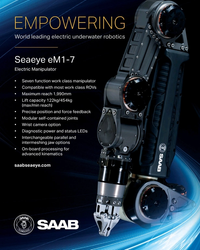 )
March 2024 - Marine Technology Reporter page: 3
)
March 2024 - Marine Technology Reporter page: 3EMPOWERING World leading electric underwater robotics Seaeye eM1-7 Electric Manipulator • Seven function work class manipulator • Compatible with most work class ROVs • Maximum reach 1,990mm • Lift capacity 122kg/454kg (max/min reach) • Precise position and force feedback • Modular self-contained
-
 )
March 2024 - Marine Technology Reporter page: 2
)
March 2024 - Marine Technology Reporter page: 2March/April 2024 On the Cover Volume 67 • Number 3 Image courtesy NIWA-Nippon Foundation TESMaP / Rebekah Parsons-King 8 Subsea Defense Black Sea Mines When the shooting stops in the Ukraine, the tough work of clearing mines will commence. By David Strachan 12 Gliders Slocum Sentinel 22 Teledyne
-
 )
April 2024 - Maritime Reporter and Engineering News page: 48
)
April 2024 - Maritime Reporter and Engineering News page: 48Index page MR Apr2024:MN INDEX PAGE 4/5/2024 1:33 PM Page 1 ANCHORS & CHAINS MILITARY SONAR SYSTEMS tel:+44 (0) 1752 723330, [email protected] , www.siliconsensing.com Anchor Marine & Supply, INC., 6545 Lindbergh Houston, Massa Products Corporation, 280 Lincoln Street, SONAR TRANSDUCERS
-
 )
April 2024 - Maritime Reporter and Engineering News page: 43
)
April 2024 - Maritime Reporter and Engineering News page: 43“The industry is an ecosystem which includes owners, managers, mariners, shipyards, equipment makers, designers, research institutes and class societies: all of them are crucial,” – Eero Lehtovaara, Head of Regulatory & Public Affairs, ABB Marine & Ports All images courtesy ABB Marine and Ports provi
-
 )
April 2024 - Maritime Reporter and Engineering News page: 42
)
April 2024 - Maritime Reporter and Engineering News page: 42OPINION: The Final Word Seeing the Ship as a System Shipping must engage with the decarbonization realities that lie ahead by changing the way it crafts maritime legislation to re? ect its place in the interconnected, interdependent world economy, said Eero Lehtovaara, ABB Marine & Ports. ABB Marine &
-
 )
April 2024 - Maritime Reporter and Engineering News page: 41
)
April 2024 - Maritime Reporter and Engineering News page: 41Nautel provides innovative, industry-leading solutions speci? cally designed for use in harsh maritime environments: • GMDSS/NAVTEX/NAVDAT coastal surveillance and transmission systems • Offshore NDB non-directional radio beacon systems for oil platform, support vessel & wind farm applications
-
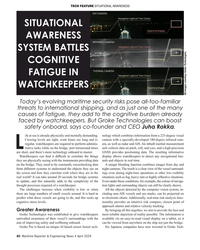 )
April 2024 - Maritime Reporter and Engineering News page: 40
)
April 2024 - Maritime Reporter and Engineering News page: 40TECH FEATURE SITUATIONAL AWARENESS SITUATIONAL AWARENESS SYSTEM BATTLES COGNITIVE FATIGUE IN WATCHKEEPERS All images courtesy Groke Technologies Today’s evolving maritime security risks pose all-too-familiar threats to international shipping, and as just one of the many causes of fatigue, they add
-
 )
April 2024 - Maritime Reporter and Engineering News page: 39
)
April 2024 - Maritime Reporter and Engineering News page: 39Tech Files Latest Products, Systems and Ship Designs “Wall Climbing Robot” Danish Pilot calls gets ClassNK Nod LEGO Model "A tribute build to a work life at sea" Image courtesy MOL, Sumitomo Heavy Industries lassNK granted its Innovation Endorse- Image courtesy Espen Andersen/DanPilot ment for
-
 )
April 2024 - Maritime Reporter and Engineering News page: 38
)
April 2024 - Maritime Reporter and Engineering News page: 38Tech Files Latest Products, Systems and Ship Designs Zero-Emission Mooring Service of a Tanker Consulmar achieved a milestone by executing what it calls ing boat Castalia, which operates on full electric propulsion. the world's ? rst zero-emissions mooring service for a tanker. Equipped with two 150 kW
-
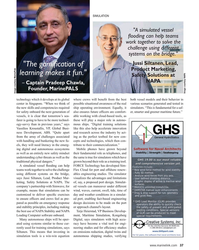 )
April 2024 - Maritime Reporter and Engineering News page: 37
)
April 2024 - Maritime Reporter and Engineering News page: 37SIMULATION "A simulated vessel ? ooding can help teams work together to solve the challenge using different systems on the bridge." – Jussi Siltanen, Lead, "The gami? cation of Product Marketing, learning makes it fun." Safety Solutions at NAPA – Captain Pradeep Chawla, Founder, MarinePALS Image
-
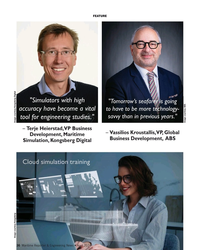 )
April 2024 - Maritime Reporter and Engineering News page: 36
)
April 2024 - Maritime Reporter and Engineering News page: 36FEATURE "Simulators with high "Tomorrow’s seafarer is going accuracy have become a vital to have to be more technology- savvy than in previous years." tool for engineering studies." Image courtesy ABS – Terje Heierstad, VP Business – Vassilios Kroustallis, VP, Global Development, Maritime Business
-
 )
April 2024 - Maritime Reporter and Engineering News page: 35
)
April 2024 - Maritime Reporter and Engineering News page: 35SIMULATION e have a close relationship with tech- Realism is prized beyond immersive, photo-realistic visu- nology, evidenced by, for example, als, and providers are introducing increasingly accurate func- the phones we are estimated to un- tionality. FORCE Technology’s upcoming DEN-Mark2 math- lock around
-
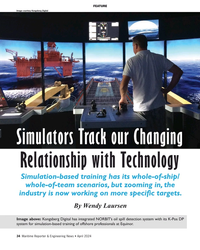 )
April 2024 - Maritime Reporter and Engineering News page: 34
)
April 2024 - Maritime Reporter and Engineering News page: 34FEATURE Image courtesy Kongsberg Digital Simulators Track our Changing Relationship with Technology Simulation-based training has its whole-of-ship/ whole-of-team scenarios, but zooming in, the industry is now working on more speci? c targets. By Wendy Laursen Image above: Kongsberg Digital has integrated
-
 )
April 2024 - Maritime Reporter and Engineering News page: 32
)
April 2024 - Maritime Reporter and Engineering News page: 32FEATURE A closeup of a blade installation process taken via drone. A blade handling system is apparent (in yellow). Images courtesy of Mammoet requirement for the development of these cranes, particularly ling area. This would result in a major time and fuel saving. in ? oating offshore wind,” says
